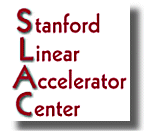| Recent
Advances in Medical Applications of Synchrotron Radiation Stanford Synchrotron Radiation Laboratory March 4-5, 2002 Program Director: Edward Rubenstein |
|
Synchrotron
Radiation in Cancer Radiotherapy: Search and Destroy
Brenda Laster and Gad Shani Departments of Biomedical Engineering and Nuclear Engineering Ben Gurion University of the Negev Beer Sheva 84105 Israel |
| The
objective of patient treatment planning protocols in cancer radiotherapy
is t
o deposit maximum energy per gram of tumor and minimize the dose
to surrounding normal tissues. However, within the tumor treatment
volume, only the cellular DNA, whose mass is merely 0.25% the mass
of the entire cell, has been identified as the critical target for
killing the cell with radiation. Therefore, the probability that the
quanta of energy emitted by photons will interact and be absorbed
at the DNA target site is e
xtremely small. One approach that can be
taken to increase the efficacy of the radiation is to introduce high
Z atoms into the DNA. These atoms have a higher probability for absorbing
radiation than that of the ordinary biological atoms (C, O, H, and
N). Furthermore, when activated by photons whose energies are suitable
for inducing a photoelectric effect in the atom, the emission of low
energy, short range Auger electrons,
can act like an energy sink directly
in the DNA. These electrons increase the effective radiation dose
to tumor while sparing surrounding normal tissues. Auger Electron
Therapy (AET) takes this approach in an attempt to improve cancer
radiotherapy. AET utilizes a drug to transport and attach high Z atoms to tumor cell DNA, and photons whose energies are suitable for inducing a photoelectric effect in the atoms to impart dense, clustered ionization directly at the critical target and significantly increase the probability of non-repairable, lethal damage to the tumor cell. This binary approach to cancer treatment can avail itself of either synchrotron radiation or implanted brachytherapy seeds as the sources of radiation, depending upon the required energy for activating the high Z atom. S ynchrotron radiation is an ideal source for use in AET because photon energies can be precisely tuned to the absorption edges of the various atoms to meet the requirements for the induction of a photoelectric effect, provided that the activating energy is capable of penetrating the body to the depth of tumor. In those cases where the activating energy is too low to achieve penetration, the interstitial implantation of radioa ctive brachytherapy seeds directly into the tumor can be applied. The therapeutic gain from the implanted radiation sources, in combination with the DNA-localized high Z atom, can then be predicted through experimentation with synchrotron radiation. X-ray micrography techniques using synchrotron radiation can also be used to search for and identify the intracellular localization of the high Z atoms within the cell. In previo us studies at the National Synchrotron Light Source at the Brookhaven National Laboratory, V-79 Chinese hamster cells were irradiated with monochromatic photons above (28 keV) and below (27.8 keV) the K absorption edge of indium (27.9 keV). Resulting cell survival curves showed that Auger electron emission in indium enhanced the radiation dose by a factor of ~2 compared to cells without indium. A factor of >1.5 was obtained in recent in vivo studies after an indium-labeled porphyrin, InTMPyP, was administered following the implantation of 125I brachytherapy seeds (average energy 28 keV) into the B16 murine melanoma born on the flank of C57 Blas mice. These results validate the fine-tuning capabilities of synchrotron radiation as a tool for predicting the therapeutic advantage that could be achieved in binary systems where drug/radiation combinations are exploited for improving cancer radiotherapy. They also demonstrate the potential of synchrotron radiation as a clinical instrument for activating atoms such as gadolinium or platinum whose higher activation energies can achieve intracorporeal penetration. |



